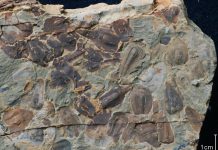
In a remarkable discovery, scientists have uncovered ten new species of ancient sea creatures known as trilobites in Thailand.
These creatures, extinct for about 490 million years, are providing vital clues to understand our planet’s past geography.
Trilobites are fascinating creatures with unique half-moon-shaped heads and an unusual way of breathing through their legs. Researchers have delved deep into these creatures in a detailed 100-page study published in “Papers in Palaeontology.”
Among these new species, one has been named in honor of Thai Royal Princess Maha Chakri Sirindhorn, recognizing her contributions to science.
The discovery of these fossils is extraordinary. They were found trapped in layers of petrified ash within sandstone. This ash, from ancient volcanic eruptions, settled on the sea floor, creating a green layer known as a tuff.
Tuffs are unique because they contain zircon crystals. Zircon is a tough mineral that can withstand heat and weather and is as hard as steel. Inside these zircons, uranium atoms slowly turn into lead atoms over time.
This slow transformation is key to dating the fossils. Nigel Hughes, a geology professor at UC Riverside and co-author of the study, explains that by using radioisotope techniques, they can determine the age of the zircon and thus the age of the volcanic eruption and the fossils.
Finding tuffs from the late Cambrian period, about 497 to 485 million years ago, is rare. This period is one of the least understood in Earth’s history. “Not many places around the world have this,” says Hughes.
The tuffs are crucial not just for dating the Thai fossils, but also for understanding other regions like China, Australia, and North America, where similar fossils exist but cannot be dated.
Shelly Wernette, a geologist involved in the study, notes that this discovery allows us to connect Thailand with parts of Australia in new and exciting ways.
The fossils were found on Ko Tarutao, an island off Thailand’s coast, part of a UNESCO geopark site. This discovery is significant as it shows Thailand was once on the edge of Gondwanaland, an ancient supercontinent.
One of the species, named after Princess Sirindhorn, Tsinania sirindhornae, stood out for its regal appearance with a broad headdress. By dating this species, researchers hope to establish the age of similar species found in China, further unraveling the ancient world’s geography.
Hughes and his team believe these fossils hold invaluable information about evolutionary changes and extinctions on Earth. “What we have here is a chronicle of evolutionary change,” says Hughes. “The more we learn from it, the better prepared we are for today’s challenges.”
This discovery not only illuminates the past but also helps us understand and prepare for the future.



